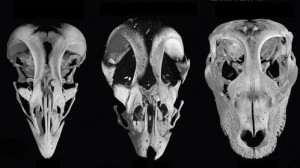Chicken Embryos with the Snouts of their Dinosaur Ancestors
A team of researchers from Harvard and Yale Universities have genetically engineered chicken embryos with snout-like features reminiscent of their ancient dinosaur ancestors. This study identifies the beak of birds as a specific adaptation and links the development of the palatine bone in the roof of the mouth to the development of bird beaks.
Dinosaur Snouts
This was no attempt to create, what the scientists euphemistically refer to as a “dino chick”, the goal was to better understand the molecular changes needed to bring about this important evolutionary transition.
It is now widely accepted that modern birds are closely related to a group of fast-running predatory dinosaurs known as the Dromaeosauridae. Popular dinosaurs such as Velociraptor and Utahraptor are dromaeosaurids. Birds are surviving relatives of dinosaurs, they are actually more closely related to the Dinosauria than to crocodiles and other reptiles.
Dinosaurs Like Velociraptor are Closely Related to Modern Birds
Picture credit: Everything Dinosaur
The picture above shows a hand-painted, scale model of a feathered Velociraptor dinosaur. This model is ideal for use in schools when teaching about inheritance and evolution as it shows the bird-dinosaur link extremely well.
For further information and to purchase this teaching resource: Beasts of the Mesozoic Articulated Dinosaur Models
From a Chicken’s Beak to a Dinosaur’s Snout
A quantitative assessment of fossils of creatures believed to be close to the avian/dinosaur root along with a study of living animals such as lizards, crocodiles, mammals and birds, such as emus was undertaken. Using this data, the research team were able to formulate a hypothesis as to how the specialised bill of birds evolved from the skull and jaws of a dinosaur.
Having examined the DNA of living organisms, the research team set about trying to inhibit the proteins that cause beak development in chicken embryos, getting them to revert back to their underlying dinosaur state.
Modifying Chicken Embryos to Create Snouts not Beaks
Picture credit: Evolution
Dr Bhullar, a palaeontologist at Yale University, who has co-authored the scientific paper on this research, was surprised by the additional changes seen in the palatine bone, he explained:
“This was unexpected and demonstrates the way in which a single, simple developmental mechanism can have wide-ranging and unexpected effects.”
Professor Michael Benton of Bristol University, who has worked extensively on the evolutionary link between dinosaurs and birds, stated that this new research identifies that the beak of birds develop very different from the snouts, noses and jaws of reptiles. A different set of genes are involved.
He stated:
“That’s what proves the beak is a real adaptation or “thing”, not just a slightly different nose shape.”
This is the first time a quantitative analysis of the fossil record and living animals has been used to identify the potential evolutionary path taken leading to specific adaptations in animals. The scientists are confident that this technique can be applied to a wide range of scientific applications involving the manipulation of genetic material to help identify development processes.
Suggested Teaching Extensions
- Genetics and Evolution (KS3) – linking to variation in a population: Variation can permit some organisms to compete more successfully, which means these organisms are more likely to breed and pass on their variations to the next generation. Looking at pictures of Archaeopteryx, a transitional bird/dinosaur with jaws and teeth challenge the class to consider the evolutionary drivers involved in the development of a toothless beak from a jaw bone with teeth.
Hint – Consider the need to lighten the body to enable more efficient powered flight.
Extension – What other adaptations can be seen in modern birds when compared to the fossils of Archaeopteryx and related dinosaurs such as Velociraptor?



